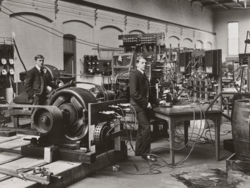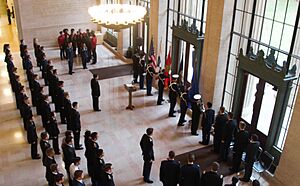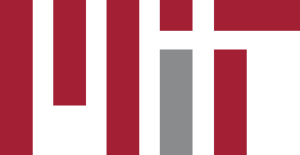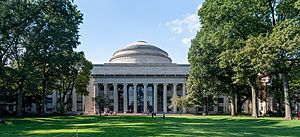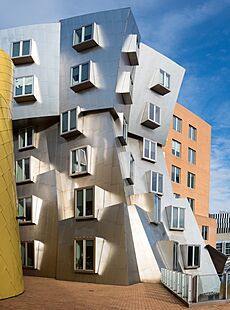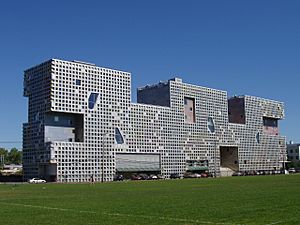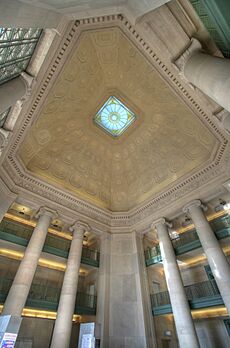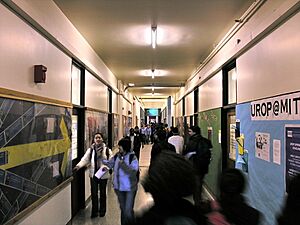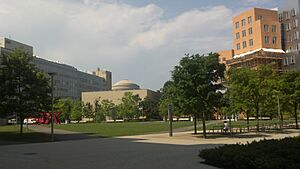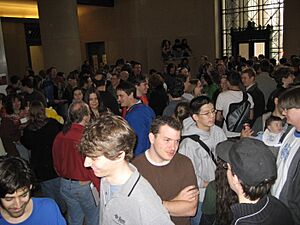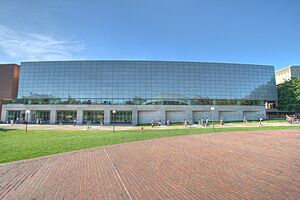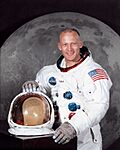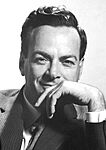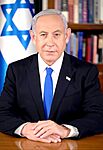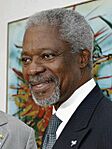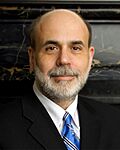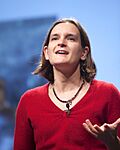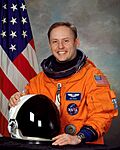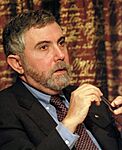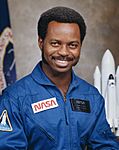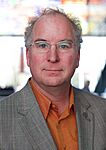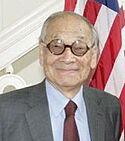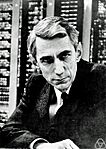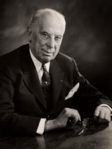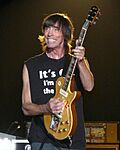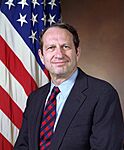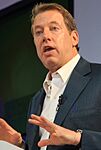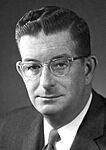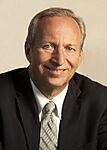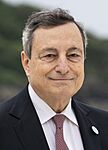Massachusetts Institute of Technology facts for kids
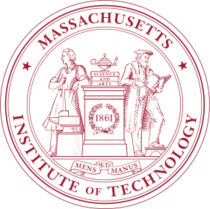 |
|
| Motto | Mens et Manus (Latin) |
|---|---|
|
Motto in English
|
"Mind and Hand" |
| Type | Private land-grant research university |
| Established | April 10, 1861 |
| Founder | William Barton Rogers |
| Accreditation | NECHE |
|
Academic affiliations
|
|
| Endowment | $24.6 billion (2024) |
| President | Sally Kornbluth |
| Provost | Anantha P. Chandrakasan |
|
Academic staff
|
1,090 |
| Students | 11,886 (2024–25) |
| Undergraduates | 4,535 (2024–25) |
| Postgraduates | 7,351 (2024–25) |
| Location |
,
United States
42°21′35″N 71°5′31″W / 42.35972°N 71.09194°W |
| Campus | Midsize city, 166 acres (67.2 ha) |
| Newspaper | The Tech |
| Colors | Cardinal Red and Steel Gray |
| Nickname | Engineers |
|
Sporting affiliations
|
|
| Mascot | Tim the Beaver |
 |
|
The Massachusetts Institute of Technology (MIT) is a famous private research university in Cambridge, Massachusetts, United States. It was started in 1861. MIT has played a big part in creating many modern technologies and scientific discoveries.
As the United States became more industrial, William Barton Rogers wanted to create a school in Boston. He aimed to teach "useful knowledge." MIT first received money from a federal land grant. It focused on a polytechnic model, which means it taught practical skills in labs. These labs focused on applied science and engineering.
MIT moved from Boston to Cambridge in 1916. It grew quickly by working with companies, the military, and new government research groups. MIT professors like Vannevar Bush helped shape these new groups. In the late 1900s, MIT became a top place for research in computer science, digital technology, artificial intelligence, and big projects like the Human Genome Project. Engineering is still its largest school. However, MIT also has strong programs in basic science, social sciences, business, and humanities.
The university has a city campus that stretches over 1.6 kilometers (1 mile) along the Charles River. Its campus is known for academic buildings connected by hallways. Many important modern buildings are also there. MIT's off-campus locations include the MIT Lincoln Laboratory and the Haystack Observatory. It also works with labs like the Broad and Whitehead Institutes. MIT has a strong spirit of starting new businesses. Many MIT graduates have founded or co-founded famous companies. Campus life is also known for clever "hacks" or pranks.
As of October 2024, 105 Nobel Prize winners, 26 Turing Award winners, and 8 Fields Medalists have been connected to MIT. These include former students, teachers, or researchers. Also, 58 people who received the National Medal of Science and 29 who received the National Medal of Technology and Innovation have ties to MIT. Many other important people, like astronauts and heads of state, have also been part of the MIT community.
Contents
Discovering MIT's Past
How MIT Began
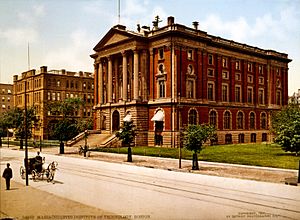
In 1859, there was an idea to use new land in Boston for a "Conservatory of Art and Science." But this idea did not happen. On April 10, 1861, the governor of Massachusetts signed a paper to officially start the Massachusetts Institute of Technology. This idea came from William Barton Rogers.
Rogers was a geologist who had just moved to Boston. He wanted to create a school that would keep up with fast scientific and technological changes. He did not want a simple job-training school. Instead, he wanted a mix of practical and general education. He believed the school should teach the scientific rules behind different skills. It should also show how these rules connect to physical laws.
Rogers' plan was like the German research university model. This model focused on professors doing their own research. It also emphasized learning through seminars and labs.
Early Years and Growth
Two days after MIT was officially started, the first battle of the Civil War happened. After a long delay because of the war, MIT's first classes began in Boston in 1865. The new school was part of the Morrill Land-Grant Colleges Act. This act helped fund schools that would offer "liberal and practical education" to working people. MIT was a land-grant school. In 1866, money from land sales helped build new buildings in Boston.
People often called MIT "Boston Tech." The school quickly adopted the European polytechnic university model. This model focused on learning in labs from the very beginning. Even with money problems, the school grew a lot in the late 1800s. This happened under President Francis Amasa Walker. New programs in electrical, chemical, marine, and sanitary engineering were added. More buildings were built, and the number of students grew to over a thousand.
The school's focus shifted more towards job training and less on pure science. MIT often struggled with money. During these "Boston Tech" years, MIT teachers and former students said no to Harvard University's repeated attempts to combine MIT with Harvard's science school. There were at least six tries to merge MIT into Harvard. MIT's Boston location was too small for it to grow. This led to a desperate search for a new campus and money. Eventually, MIT leaders agreed to merge with Harvard and move. But MIT teachers, students, and alumni strongly disagreed. The merger plan failed in 1905. A court ruled that MIT could not sell its Boston land.
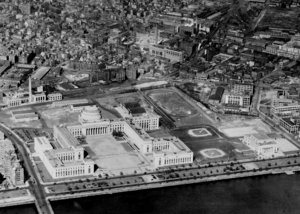
In 1912, MIT bought its current campus. This was a 1.6 km (1 mile) area of filled land along the Charles River in Cambridge. The neoclassical "New Technology" campus was designed by William W. Bosworth. It was mostly paid for by secret donations from a mysterious "Mr. Smith." In January 1920, the donor was revealed to be George Eastman. He invented film production methods and started Eastman Kodak. Between 1912 and 1920, Eastman gave MIT $20 million in cash and Kodak stock. In 1916, when the first academic buildings were ready, MIT's leaders and its official charter crossed the Charles River. They used a special boat called Bucentaur.
MIT needed more money to match Eastman's gift and make up for less state support. In 1920, President Richard C. MacLaurin started a new way to get money from industries. This was called the "Technology Plan." As MIT grew, it created new advanced programs. These programs focused on lab work for industry problems. This included a new electrical engineering program. Gerard Swope, who led MIT and General Electric, believed engineers needed scientific research training. In 1930, he brought in Karl Taylor Compton. Compton helped MIT become a "technological" research university. He also helped it become more independent from private companies.
Changes in Learning
In the 1930s, President Karl Taylor Compton and Vice-President Vannevar Bush stressed the importance of pure sciences like physics and chemistry. They reduced the amount of vocational training in workshops. These changes helped MIT become known for leadership in science as well as engineering. Unlike Ivy League schools, MIT served more middle-class families. It relied more on tuition fees than on large gifts or grants for money.
Even in 1949, a report said that many people still saw MIT as mainly a job-training school. The report wanted to change this view. It looked closely at the undergraduate courses. It suggested offering a broader education. It also warned against letting engineering and government research take away from science and humanities. The School of Humanities, Arts, and Social Sciences and the MIT Sloan School of Management were created in 1950. They aimed to be as strong as the Schools of Science and Engineering.
Research for Defense
MIT's involvement in military research grew a lot during World War II. In 1941, Vannevar Bush became head of the federal Office of Scientific Research and Development. He sent money to only a few universities, including MIT. Engineers and scientists from all over the country came to MIT's Radiation Laboratory. This lab was started in 1940 to help the British military develop microwave radar. The work there greatly impacted the war and future research. Other defense projects included control systems for guns and bombs. They also worked on inertial navigation under Charles Stark Draper's lab. They developed a digital computer for flight simulations and high-speed photography. By the end of the war, MIT was the nation's biggest wartime research contractor.
After the war, government-funded research continued at MIT. This included projects like SAGE and guidance systems for ballistic missiles and Project Apollo. These activities changed MIT a lot. By the 1950s, MIT had strong ties with new supporters: foundations and the federal government.
In the late 1960s and early 1970s, students and teachers protested against the Vietnam War. They also protested MIT's defense research. During this time, MIT departments researched helicopters, smart bombs, and ways to fight rebellions for the war. They also worked on guidance systems for nuclear missiles. The Union of Concerned Scientists was formed in 1969. This group wanted to shift research from military to environmental and social problems. MIT eventually separated from its Instrumentation Laboratory. It moved all secret research off-campus in 1973 because of the protests.
Recent Times at MIT
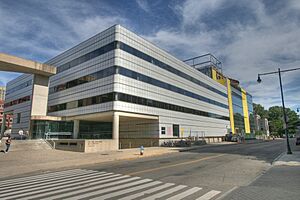
MIT has kept up with and helped advance the digital age. Students and staff at Project MAC and the Artificial Intelligence Laboratory created some of the first interactive computer video games. They also created much of the modern hacker culture. Several big computer groups started at MIT since the 1980s. These include Richard Stallman's GNU Project and the Free Software Foundation. The MIT Media Lab was founded in 1985 to research new uses for computer technology. The World Wide Web Consortium (W3C) was founded at MIT in 1994 by Tim Berners-Lee.
The OpenCourseWare project has offered free online course materials since 2002. The One Laptop per Child project started in 2005. It aimed to bring computer education to children worldwide.
MIT was named a sea-grant college in 1976. This supported its oceanography and marine science programs. It became a space-grant college in 1989. This supported its aeronautics and astronautics programs. Even with less government money, MIT raised funds to expand its campus. New dorms, athletic buildings, and research centers were built.
In 2001, MIT launched OpenCourseWare. This project made lecture notes, homework, and exams from most of its courses available online for free. In 2011, MIT announced "MITx." This program offered official certificates for online courses for a small fee. The "edX" online platform was developed with Harvard. It is open source, meaning other universities can use it.
MIT has its own police force. In April 2013, after the Boston Marathon bombing, MIT Police officer Sean Collier was killed by the suspects. This led to a large search that closed the campus. A week later, over 10,000 people attended Collier's memorial service. In November 2013, MIT created the Collier Medal. It is given yearly to someone who shows kindness and helps the community.
In September 2017, MIT announced a new artificial intelligence research lab. It is called the MIT-IBM Watson AI Lab. In October 2018, MIT said it would open a new Schwarzman College of Computing. This college focuses on AI and how it can be used in many fields. The cost for buildings and new teachers was expected to be $1 billion.
The Laser Interferometer Gravitational-Wave Observatory (LIGO) was designed by scientists from California Institute of Technology, MIT, and companies. It was funded by the National Science Foundation. LIGO was built to find gravitational waves. These waves were predicted by general relativity. Gravitational waves were first found by the LIGO detector in 2015. For their work on LIGO, two Caltech physicists and MIT physicist Rainer Weiss won the Nobel Prize in physics in 2017. Weiss, an MIT graduate, designed the laser technique used in LIGO.
In April 2024, MIT students joined protests on other campuses. They set up camps against the Gaza war. Students compared their actions to past protests against the Vietnam War and MIT's investments in South African apartheid. They asked MIT to end its ties with the Israeli Ministry of Defense.
Exploring the Campus
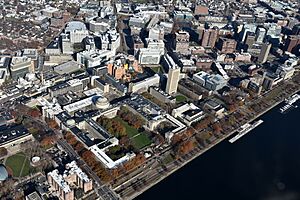
MIT's campus is 166 acres (67 hectares) in Cambridge. It stretches about 1.6 kilometers (1 mile) along the north side of the Charles River basin. Massachusetts Avenue divides the campus roughly in half. Most dorms and student life areas are to the west. Most academic buildings are to the east. The Harvard Bridge is the closest bridge to MIT. It is famous for being measured in a funny unit called the smoot.
The Kendall/MIT MBTA Red Line subway station is on the northeastern edge of campus. This area is Kendall Square. The neighborhoods around MIT have many high-tech companies. They also have diverse residential areas. In early 2016, MIT shared a plan to develop Kendall Square. This plan included new educational, retail, and housing spaces. The MIT Museum moved next to a Kendall Square subway entrance. It joined the List Visual Arts Center on the eastern side of campus.
Each building at MIT has a number. Most also have a name. Academic buildings are usually called by their number. Dorms are called by their name. The building numbers generally follow when they were built and their location. Many buildings are connected above ground and through tunnels. These tunnels offer protection from the weather. They are also used for roof and tunnel hacking.
The campus mainly uses natural gas for energy. MIT has also updated old buildings to save energy. It uses alternative fuel shuttles and helps students pay for public transport. It also has solar power offsets and a plant that creates electricity, heat, and cooling.
Research Spaces
MIT's on-campus nuclear reactor is one of the most powerful university reactors in the U.S. Its location in a busy area has caused some debate. But MIT says it is very safe.
MIT Nano, also called Building 12, is a lab for tiny-scale research. Its 100,000 square feet (9,300 square meters) of cleanroom space is the largest of its kind in the nation. It cost $400 million, making it one of the most expensive buildings on campus. The facility also has advanced nano-imaging tools.
Other important campus facilities include a wind tunnel for testing aerodynamic research. There is also a towing tank for testing ship designs. MIT's campus-wide wireless network was finished in 2005. It has nearly 3,000 access points covering 9.4 million square feet (870,000 square meters) of campus.
Campus Buildings
MIT's School of Architecture started in 1865. It was the first official architecture program in the U.S. It has a history of building modern and unique structures. The first buildings on the Cambridge campus, finished in 1916, are called the "Maclaurin buildings." They were designed by William Welles Bosworth. These large buildings were made of reinforced concrete, a first for a university building in the U.S. Bosworth's design was inspired by the City Beautiful Movement. It features the Pantheon-like Great Dome, which holds the Barker Engineering Library. The Great Dome looks over Killian Court, where graduation ceremonies are held. The buildings around Killian Court have names of important scientists and thinkers carved into them. The large Building 7 entrance at 77 Massachusetts Avenue is seen as the main entry to the Infinite Corridor and the rest of campus.
Buildings like Alvar Aalto's Baker House (1947) and Eero Saarinen's MIT Chapel and Kresge Auditorium (1955) are examples of post-war modernist architecture. Newer buildings like Frank Gehry's Stata Center (2004) and Steven Holl's Simmons Hall (2002) stand out. These buildings are sometimes called "starchitecture." Not everyone has liked these buildings. In 2010, The Princeton Review listed MIT among schools with "tiny, unsightly, or both" campuses.
Student Housing
Undergraduates are guaranteed housing for four years in one of MIT's 11 dorms. Students living on campus get help from graduate student tutors and faculty housemasters. Housing is based on student choices, so different dorms have different social vibes. For example, East Campus is known for its unique culture. MIT also has 5 dorms for single graduate students and 2 apartment buildings for married student families.
MIT has many fraternities, sororities, and independent living groups (FSILGs). As of 2015, 98% of all undergraduates lived in MIT-connected housing. Many men (54%) were in fraternities, and many women (20%) were in sororities. Most FSILGs are in Back Bay, near where MIT first started. There are also fraternities on MIT's West Campus. After a student's death in 1997, MIT required all freshmen to live in dorms starting in 2002.
In 2013–2014, MIT closed and tore down Bexley Hall dorm due to water damage. In 2017, Senior House dorm was closed after 100 years. MIT showed that only 60% of Senior House residents graduated in four years. The campus-wide four-year graduation rate is 84%.
MIT's Land Outside Campus
MIT owns a lot of commercial real estate in Cambridge. It pays property taxes on this land. It also makes extra payments on academic buildings that are usually tax-exempt. As of 2017, MIT is the largest taxpayer in Cambridge. It contributes about 14% of the city's yearly income. Its properties include Technology Square, parts of Kendall Square, and many properties in nearby neighborhoods. This land is held for investment and possible future expansion.
How MIT is Organized
MIT is a nonprofit corporation run by a private board called the MIT Corporation. This board has 60–80 members. They approve the budget, new programs, degrees, and faculty hires. They also choose a president to lead the university. The current president is Sally Kornbluth. She became MIT's eighteenth president in January 2023.
MIT has five schools: Science, Engineering, Architecture and Planning, Management, and Humanities, Arts, and Social Sciences. It also has one college, the Schwarzman College of Computing. However, it does not have schools for law or medicine.
Faculty committees help control many parts of MIT's courses, research, and student life. The head of each academic department reports to the dean of that school. The dean then reports to the Provost, who works under the President. Special "Visiting Committees" also review each department's work.
MIT's money, land, and other financial assets are managed by the MIT Investment Management Company (MITIMCo). This company was created in 2004. The money MIT has saved, called its endowment, has grown a lot since the 1990s. This makes it one of the largest university endowments in the U.S. It owns most shares in the audio company Bose Corporation. It also has many commercial properties in Kendall Square.
Learning at MIT
| Admissions statistics | |
|---|---|
|
2022 entering
classChange vs. 2017 |
|
| Admit rate | 4.0%
(
|
| Yield rate | 85.0%
(
|
| Test scores middle 50% | |
| SAT Total | 1520–1570 |
| ACT Composite | 35–36 |
MIT is a large research university with many students living on campus. Most students are in graduate programs. The university has been officially approved by the New England Association of Schools and Colleges since 1929. MIT uses a 4–1–4 academic calendar. The fall semester starts after Labor Day and ends in mid-December. There is a 4-week "Independent Activities Period" in January. The spring semester starts in early February and ends in late May.
MIT students use numbers or acronyms for their majors and classes. Departments are numbered in the order they were founded. For example, Civil and Environmental Engineering is Course 1. Linguistics and Philosophy is Course 24. Students studying Electrical Engineering and Computer Science (EECS) are called "Course 6." MIT students combine the department's number with the class number. For example, the first calculus-based classical mechanics class is "8.01."
Undergraduate Studies
| Academic Year | Undergraduates | Graduate | Total Enrollment |
|---|---|---|---|
| 2017–2018 | 4,547 | 6,919 | 11,466 |
| 2018–2019 | 4,602 | 6,972 | 11,574 |
| 2019–2020 | 4,530 | 6,990 | 11,520 |
| 2020–2021 | 4,361 | 6,893 | 11,254 |
| 2021–2022 | 4,638 | 7,296 | 11,934 |
| 2022–2023 | 4,657 | 7,201 | 11,858 |
The four-year undergraduate program balances professional majors with arts and sciences. In 2010, U.S. News called it "most selective." It admitted 4.1% of applicants in 2020–2021. MIT offers 44 undergraduate degrees. In 2017–2018, 1,045 Bachelor of Science degrees were given. This is the only type of undergraduate degree MIT now awards. In fall 2011, the School of Engineering was the most popular. It had 63% of students. The School of Science had 29%.
All undergraduates must complete core classes called General Institute Requirements (GIRs). The Science Requirement includes two semesters of physics, two of calculus, one of chemistry, and one of biology. There is also a Lab Requirement. The Humanities, Arts, and Social Sciences (HASS) Requirement means eight semesters of classes in these areas. Students also need to take "communication-intensive" classes. Finally, all students must pass a swimming test. Non-athletes must also take four quarters of physical education classes.
Most classes have lectures, small group sessions led by teachers, weekly homework, and tests. MIT coursework is known for being very challenging. However, the number of freshmen who stay at MIT is similar to other universities. A "pass/no-record" grading system helps first-year students. For fall classes, freshmen transcripts only show if a class was passed. If not, there is no record. In spring, passing grades (A, B, C) appear, but non-passing grades are not recorded.
MIT's courses encourage students to use science in practical ways. This idea is summed up in the motto mens et manus ("mind and hand"). Classes focus on using engineering knowledge in areas like product design. In 1969, Margaret MacVicar started the Undergraduate Research Opportunities Program (UROP). This program lets undergraduates work directly with professors and researchers. Students join research projects for credit, pay, or as volunteers. Most undergraduates take part. Students often get their work published or start new companies based on their UROP experience. This program has been copied by many other U.S. universities.
Graduate Studies
MIT's graduate program works closely with the undergraduate program. Many courses are taken by students at both levels. MIT offers many doctoral degrees in humanities, social sciences, and STEM fields. It also offers professional degrees, like the Master of Business Administration (MBA). The Institute offers graduate degrees like the Master of Science (MS), Engineer's Degrees, Doctor of Philosophy (PhD), and Doctor of Science (DSc). It also has joint programs, like an MD-PhD with Harvard Medical School.
Admission to graduate programs is handled by each department. More than 90% of doctoral students receive financial support. This comes from fellowships, research assistantships, or teaching assistantships.
University Rankings
| ARWU World | 3 |
|---|---|
| THES World | 2 |
| USNWR National University | 2 |
| Washington Monthly National University | 3 |
| Forbes | 3 |
MIT is consistently ranked among the top five universities globally. For many years, U.S. News & World Report, the QS World University Rankings, and the Academic Ranking of World Universities have ranked MIT's School of Engineering first. MIT also ranks highly in computer science, natural sciences, business, architecture, economics, linguistics, mathematics, and political science.
Times Higher Education has called MIT one of the world's "six super brands." These include Berkeley, Cambridge, Harvard, Oxford, and Stanford. In 2019, it was ranked #3 among universities worldwide by SCImago Institutions Rankings. In 2017, the Times Higher Education World University Rankings also rated MIT the #2 university for arts and humanities.
Working with Others
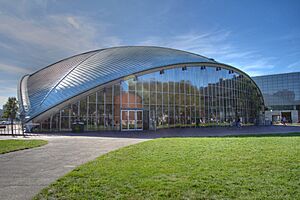
MIT has a history of working with schools, companies, and the government on research and training. In 1946, President Compton and others started American Research and Development Corporation. This was the first American venture-capital firm. In 1948, Compton created the MIT Industrial Liaison Program.
In the late 1980s and early 1990s, some politicians said MIT and other universities were hurting the economy. They claimed MIT was giving taxpayer-funded research to foreign companies. However, MIT's work with the government on research has led to many MIT leaders becoming scientific advisors to presidents since 1940. MIT opened a Washington Office in 1991 to continue getting research funding.
The U.S. Justice Department investigated MIT in 1989. In 1991, it sued MIT and other schools. It claimed they were working together to set prices for student aid. The other schools settled, but MIT fought the charges. MIT argued that its practice helped ensure aid for the most students. MIT won the case in 1994.
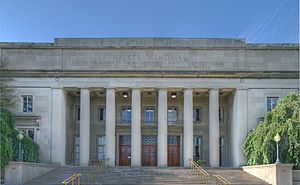
MIT's closeness to Harvard University has led to many research collaborations. Examples include the Harvard-MIT Division of Health Sciences and Technology and the Broad Institute. Students at both schools can take classes at the other school for credit without extra fees. MIT also has a cross-registration program with Wellesley College since 1969. In 2002, the Cambridge–MIT Institute started a student exchange program with the University of Cambridge. MIT also works with Imperial College London.
MIT works closely with independent research groups in Boston. These include the Charles Stark Draper Laboratory and the Whitehead Institute for Biomedical Research. International research collaborations include the Amsterdam Institute for Advanced Metropolitan Solutions and the Singapore-MIT Alliance.
The magazine Technology Review is published by MIT. The MIT Press is a major university press. It publishes over 200 books and 30 journals each year. It focuses on science, technology, arts, and social issues.
In 2022, Open Philanthropy gave $13,277,348 to MIT. This money was for studying possible risks from AI.
Libraries and Museums
The MIT library system has five main libraries: Barker (Engineering), Dewey (Economics), Hayden (Humanities and Science), Lewis (Music), and Rotch (Arts and Architecture). There are also special libraries and archives. The libraries have over 2.9 million printed books and many digital resources. The Lewis Music Library focuses on 20th and 21st-century music. The List Visual Arts Center shows modern art. MIT uses a part of its building budget to buy public art and outdoor sculptures.
The MIT Museum started in 1971. It collects and shows items important to MIT's culture and history. The museum also has educational programs for the public. This includes the yearly Cambridge Science Festival. Since 2005, its goal has been to share MIT's science and technology with the world.
Research at MIT
MIT was chosen to join the Association of American Universities in 1934. It is known for "Very high research activity." Its research spending was $952 million in 2017. The U.S. government was the biggest source of research money. MIT has about 1300 researchers besides its professors. In 2011, MIT faculty and researchers created 632 inventions. They were given 153 patents and earned $85.4 million in income.
In electronics, magnetic-core memory, radar, and inertial guidance controls were invented or greatly improved by MIT researchers. Harold Eugene Edgerton was a leader in high-speed photography and sonar. Claude E. Shannon developed much of modern information theory. In computer science, MIT researchers made key contributions to cybernetics, artificial intelligence, computer languages, and cryptography.
Current and past physics professors have won eight Nobel Prizes. Chemistry department members have won three Nobel Prizes. MIT biologists have won six Nobel Prizes for their work in genetics and molecular biology. Professor Eric Lander was a main leader of the Human Genome Project. Positronium atoms and synthetic penicillin were first discovered at MIT.
In humanities and social sciences, MIT economists have won seven Nobel Prizes. Linguists Noam Chomsky and Morris Halle wrote important books on grammar. The MIT Media Lab, started in 1985, is known for its unusual research. It has been home to influential researchers like constructivist educator Seymour Papert.
Fifty people connected to MIT have received MacArthur Fellowships (called "Genius Grants"). Five Pulitzer Prize-winning writers work at or have retired from MIT.
Discoveries and New Ideas
Science Breakthroughs
- Oncogene – Robert Weinberg found the genetic cause of human cancer.
- Reverse transcription – David Baltimore found two RNA tumor viruses at MIT in 1970.
- Thermal death time – Samuel Cate Prescott and William Lyman Underwood worked on this from 1895 to 1898 for canning food.
- Electroweak interaction – Steven Weinberg suggested the electroweak unification theory at MIT in 1967.
Computer and Applied Science Innovations
- Akamai Technologies – Daniel Lewin and Tom Leighton created a faster content delivery network. It now handles a large part of all web traffic.
- Cryptography – MIT researchers Ron Rivest, Adi Shamir, and Leonard Adleman developed the RSA cryptosystem.
- Digital circuits – Claude Shannon, while a student at MIT, developed the theory for digital circuit design. This led to modern computers.
- Electronic ink – developed by Joseph Jacobson at MIT Media Lab.
- Emacs (text editor) – development started in the 1970s at the MIT AI Lab.
- Flight recorder (black box) – Charles Stark Draper developed the black box at MIT's Instrumentation Laboratory. This lab also designed the Apollo Guidance Computer for NASA.
- GNU Project – Richard Stallman officially started the free software movement in 1983 at MIT.
- Julia (programming language) – Development began in 2009 by Jeff Bezanson, Stefan Karpinski, Viral B. Shah, and Alan Edelman at MIT.
- Lisp (programming language) – John McCarthy invented Lisp at MIT in 1958.
- Lithium-ion battery efficiencies – Yet-Ming Chiang and his team at MIT greatly improved lithium batteries.
- Macsyma, an old computer algebra system; the free version Maxima is still widely used.
- MIT OpenCourseWare – the OpenCourseWare movement grew with the launch of MIT OpenCourseWare in 2002.
- Perdix micro-drone – an autonomous drone that uses artificial intelligence to fly with other drones.
- Project MAC – important research in operating systems and artificial intelligence.
- Radar – developed at MIT's Radiation Laboratory during World War II.
- SKETCHPAD – invented by Ivan Sutherland at MIT. It was a pioneer for human–computer interaction (HCI) and computer graphics.
- VisiCalc – the first spreadsheet computer program for personal computers. MIT alumni Dan Bricklin and Bob Frankston created it.
- World Wide Web Consortium – founded in 1994 by Tim Berners-Lee. It sets international standards for the World Wide Web.
- X Window System – a system for graphical user interfaces used for Unix and Linux systems.
Companies Started by MIT Alumni
MIT alumni and faculty have started many companies:
- Analog Devices, 1965, co-founders Ray Stata and Matthew Lorber
- BlackRock, 1988, co-founder Bennett Golub
- Bose Corporation, 1964, founder Amar Bose
- Boston Dynamics, 1992, founder Marc Raibert
- Buzzfeed, 2006, co-founder Jonah Peretti
- Dropbox, 2007, founders Drew Houston and Arash Ferdowsi
- Hewlett-Packard, 1939, co-founder William R. Hewlett
- HuffPost, 2005, co-founder Jonah Peretti
- Intel, 1968, co-founder Robert Noyce
- Khan Academy, 2008, founder Salman Khan
- Koch Industries, 1940, founder Fred C. Koch
- Qualcomm, 1985, co-founders Irwin M. Jacobs and Andrew Viterbi
- Raytheon, 1922, co-founder Vannevar Bush
- Renaissance Technologies, 1982, founder James Simons
- Scale AI, 2016, founder Alexandr Wang
- Texas Instruments, 1930, founder Cecil Howard Green
- TSMC, 1987, founder Morris Chang
- VMware, 1998, co-founder Diane Greene
Traditions and Student Life
MIT values hard work and technical skill. It has never given out honorary degrees. It also does not give sports scholarships or special honors for grades. However, MIT has given honorary professorships twice: to Winston Churchill in 1949 and Salman Rushdie in 1993.
Many older students and alumni wear a large, heavy class ring called the "Brass Rat." It was first made in 1929. The ring's design changes slightly each year. But it always has three parts: the MIT seal, the class year, and a beaver. The letters IHTFP are sometimes on the ring. This stands for "I Have Truly Found Paradise" or other funny phrases.
The Caltech Rivalry
MIT has a well-known rivalry with the California Institute of Technology (Caltech). Both schools are known as top science and engineering universities. This rivalry is unusual because it focuses on academics and pranks, not sports. The schools are also very far apart. In 2005, Caltech students pranked MIT's Campus Preview Weekend. They gave out t-shirts that said "MIT" on the front and "...because not everyone can go to Caltech" on the back. They also covered part of the "Massachusetts Institute of Technology" sign on a building.
In 2006, MIT got back at them. Students pretended to be contractors and took the 1.7-ton Fleming cannon from Caltech. The cannon was moved to Cambridge and displayed at MIT. In 2010, MIT students tried to put a life-sized model of the TARDIS from Doctor Who on a Caltech building. A few months later, Caltech students helped MIT students put the TARDIS where they first wanted it. The rivalry continued in 2014. Caltech students gave out mugs with the MIT logo. When heated, the mugs turned orange and said, "Caltech, The Hotter Institute of Technology."
Student Activities
MIT has over 500 student groups. These include a campus radio station, The Tech student newspaper, and an annual business competition. There's also a crime club and weekly movie screenings. Less common activities include the "world's largest open-shelf collection of science fiction" and a model railroad club. Students, teachers, and staff are involved in over 50 outreach programs.
Fraternities and sororities offer many activities and housing. About 1,000 undergraduates, nearly half of the men and a third of the women, are part of these groups.
The Independent Activities Period is a four-week "term" in January. It offers hundreds of optional classes, lectures, and activities. Popular activities include robot design and programming competitions. There's also the annual "mystery hunt" and Charm School. Over 250 students also do internships at companies in the U.S. and other countries.
Many MIT students also enjoy "hacking." This means exploring places that are usually off-limits, like rooftops and steam tunnels. It also means doing clever practical jokes. Famous hacks include taking Caltech's cannon and putting a Wright Flyer on top of the Great Dome.
Sports at MIT
MIT has 31 varsity sports teams. It has one of the largest NCAA Division III athletic programs. MIT competes in the NCAA's Division III. It also competes in NCAA Division I for women's crew and men's water polo.
MIT's sports teams are called the Engineers. They have won 22 Team National Championships and 42 Individual National Championships. MIT leads Division III in producing Academic All-Americas (302). It ranks second across all NCAA Divisions. MIT athletes have won 13 Elite 90 awards. In April 2009, MIT cut eight of its 41 sports due to budget cuts.
People of MIT
Students at MIT
| Race and ethnicity | Total | ||
|---|---|---|---|
| Asian | 34% |
|
|
| White | 22% |
|
|
| Hispanic | 15% |
|
|
| Foreign national | 11% |
|
|
| Other | 10% |
|
|
| Black | 8% |
|
|
| Economic diversity | |||
| Low-income | 19% |
|
|
| Affluent | 81% |
|
|
MIT had 4,602 undergraduate students and 6,972 graduate students in 2018–2019. Students came from all 50 U.S. states and 115 other countries.
MIT received 33,240 applications for the undergraduate Class of 2025. It accepted 1,365 students (4.1 percent). In 2019, 29,114 applications were received for graduate programs. 3,670 were accepted (12.6 percent). In August 2024, after a court ruling, the number of Black and Latino students decreased for the class of 2028. Asian American enrollment increased.
Undergraduate tuition and fees for 2019–2020 were $53,790 for nine months. 59% of students received a scholarship from MIT based on their financial need. Graduate tuition and fees were also $53,790 for nine months. Financial help for graduate students mostly comes from departments. This includes fellowships and assistantships. The rising cost of tuition led to a student tradition of funny "tuition riots."
MIT has allowed both male and female students since 1870. Ellen Swallow Richards was the first female student. She also became the first female faculty member. Before 1963, female students were a small group. The number of women grew from 34% to 45% of undergraduates between 1993 and 2009.
Teachers and Staff
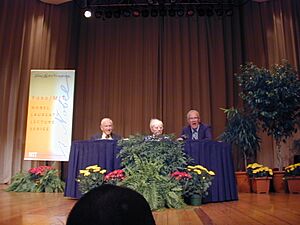
As of 2025, MIT had 1,090 faculty members. Teachers give lectures, advise students, and do original research. Between 1964 and 2009, 17 faculty and staff members won Nobel Prizes. As of October 2020, 37 MIT faculty members, past or present, have won Nobel Prizes. Most were in Economics or Physics.
As of October 2013, current faculty included 67 Guggenheim Fellows and 22 MacArthur Fellows. Professors who make amazing contributions are given special appointments as Institute Professors. Susan Hockfield, a molecular neurobiologist, was MIT's president from 2004 to 2012. She was the first woman to hold this position.
MIT faculty members are often chosen to lead other universities. For example, former provost Robert A. Brown became president of Boston University. Former professor David Baltimore was president of Caltech.
Also, faculty members have been chosen to lead government agencies. For example, former professor Marcia McNutt is president of the National Academy of Sciences. In 2013, faculty member Ernest Moniz became the United States Secretary of Energy. A 1999 report found that senior female faculty in the School of Science were sometimes treated unfairly. They received less pay and resources compared to men with similar achievements.
As of 2017, MIT was the second-largest employer in Cambridge. In 2013, employees ranked MIT as the #7 best place to work among U.S. colleges. They described it as a "smart," "creative," and "friendly" place. They noted a "strong work ethic" but complained about "low pay" compared to industry jobs.
Famous Alumni
Many of MIT's over 120,000 alumni have achieved great success. This includes scientific research, public service, education, and business. As of October 2020, 41 MIT alumni have won Nobel Prizes. Many have also received other important scholarships.
Alumni in U.S. politics include former Chairman of the Federal Reserve Ben Bernanke. MIT alumni have founded or co-founded many famous companies. These include Intel, Bose, Dropbox, and Campbell Soup. A survey found that living MIT alumni have started 25,800 companies. These companies employ over three million people. They generate about $1.9 trillion in global revenues each year. If these companies were a country, they would have the 11th-highest GDP in the world.
More than one-third of the United States' crewed spaceflights have included MIT-educated astronauts. This is more than any university except the U.S. service academies. Of the 12 people who have walked on the Moon, four graduated from MIT. This includes Apollo 11 astronaut Buzz Aldrin. Alumnus Qian Xuesen led the Chinese nuclear-weapons program.
Famous alumni in other fields include children's book author Hugh Lofting. Also, sculptor Daniel Chester French and guitarist Tom Scholz from the band Boston. Other notable alumni include Nobel Prize-winning economist Paul Krugman and architect Cass Gilbert.
-
Apollo 11 astronaut Buzz Aldrin, ScD 1963
-
Physics Nobel laureate Richard Feynman, SB 1939
-
Prime Minister of Israel, Benjamin Netanyahu, BS 1975 & MS 1976
-
UN Secretary-General Kofi Annan, SM 1972
-
Federal Reserve Bank chairman Ben Bernanke, PhD 1979
-
Economics Nobel laureate Esther Duflo, PhD 1999
-
Actress, Entrepreneur Bridgit Mendler, SM 2020
-
Economics Nobel laureate Paul Krugman, PhD 1977
-
Internet Archive founder Brewster Kahle, SB 1982
-
Architect I. M. Pei, BArch 1940
-
"Father of the Information Age", Claude Shannon, PhD 1940
-
General Motors CEO Alfred P. Sloan, SB 1895
-
Ford Chairman William Clay Ford, Jr., SM 1984
-
Chemistry Nobel laureate Robert Burns Woodward, SB 1936, PhD 1937
-
Treasury Secretary Lawrence Summers, SB 1984
-
Prime Minister of Italy Mario Draghi, PhD 1977
See also
 In Spanish: Instituto de Tecnología de Massachusetts para niños
In Spanish: Instituto de Tecnología de Massachusetts para niños
- Massachusetts Institute of Technology School of Engineering
- Whitehead Institute
- Eli and Edythe L. Broad Institute of MIT and Harvard
- Koch Institute for Integrative Cancer Research
- The Coop, campus bookstore


